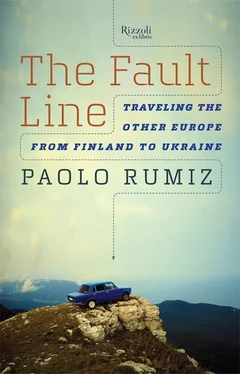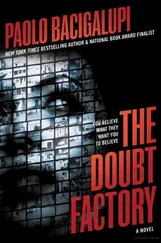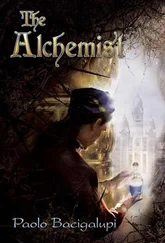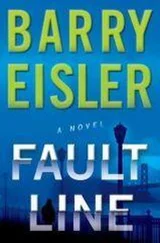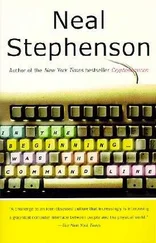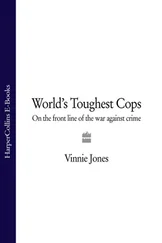What does Europe know about the wounds inflicted here? What history book in Italy tells about this tragedy, as large as the Istrian exodus multiplied by thirty, yet which is still nothing compared to the deportations in Russia? In 1945, after the concentration camps and the Stalinist deportations, the engineers of ethnic cleansing were still at work. From the eastern territories ceded to Russia, the party brought to this place waves of Poles terrorized by the bloodthirsty hate of the Ukrainians for their former masters. With horrific symmetry, it sent eastward millions of Ukrainians who had been trapped inside the new borders, to die of winter in a Ukraine stripped of its population by the Nazi war and by Stalinism’s siege of hunger against the peasants.
But there was still room in the immense void left by the expulsion of the Germans, and so in 1947 Operation Vistula was launched by the Communist government of Poland. The southern frontier needed to be “purified.” The minorities near Czechoslovakia—innocent peoples, mountaineers like the Lemkos and the Boykos, or people without a homeland, like the Gypsies (to whom Monika has dedicated years of work)—came to be judged as ethnically suspect. They were forcibly deported with barely two hours’ notice, and sprinkled about in the villages of western Poland already inhabited by the first wave of refugees from the East, to die of homesickness in camps with no horizons, where the wind encountered no obstacles and froze their souls as well as their bodies.
They were in a land of refugees, but since they were the last to arrive, they were more refugee than the others. They were called przwitrzeni , those carried by the wind. People were afraid of them. The police had spread panic before they arrived. “The bandits are coming,” said the police officers in charge of the deportation. They spread fear because distrust among exiles was useful to the regime and kept the people in submission. But it wasn’t over. The last wave of Stalinist terror was unleashed in Ukraine and the Poles who were still there also escaped to the west. When all the moving was done, nine million people had changed countries between 1945 and 1956.
Janina, Monika’s aunt born in 1940, today a lawyer in Wroclaw, escaped from Ukraine when she was six, with her mother, two suitcases, and her six-month-old baby brother. It was the winter of 1946, and her father was still missing in action in Germany. They put her on a train, on the same line and in the same freight cars that had transported Jews to Treblinka. It took them two months to go from Lviv to Lublin. Sixty days to go 120 miles. She adds: “They parked us on dead tracks, in the middle of the snow. The Soviet soldiers came and robbed us.”
During that same winter, Janina’s father tried to make his way home on foot from the German concentration camp where he had been locked up, and the only way to find his family was to wait at the border, on the train tracks. He waited for weeks for the great move to the East to be completed, until the right train came by and the family was reunited. Then they were offered a house that used to belong to Germans, in former Silesia, near Wroclaw. It sounds like a novel by Pasternak, but everyone in Poland, says Monika, has stories like that.
Today, the Poles from the east, like Janina, live in western Poland, where the great void left by the Germans weighs on their souls like the Jewish void in Latvia, Ukraine, and along the Danube. It is a land of ghosts and the uprooted, where still today the question asked in order to get to know someone is not “Where do you live?” but “Where are you from?” and where the biggest hidden fear is the fear of the return of the old masters, the Germans. In the meantime, in Berlin, the German exile lobby starts to put pressure on again. National public television hammers away with reports on the newly admitted EU member countries to the east, talks about “Germans and Poles deported due to ‘no fault of their own,’” the latter to the homes of the former. But behind the equanimity hides the trap of revisionism. “I don’t like what they’re saying,” Monika explains. “The Germans have their responsibility, and then some. We, on the other hand, didn’t wage war; we only suffered its consequences.”
The train jolts up and down with a clanging of hardware on the boards of the bridge over the eastern branch of the Vistula, and stops in the dark in front of the magnificent station in Malbork, intact in its Prussian red brick, the ghost of a lost Europe. The train will continue to Berlin, but this is where we get off to catch our connecting train to Warsaw and also where we see, given that we’re here, the famous castle of the Teutonic Knights, the border monument that many Poles look upon as an advance guard of the Nazi invasion of 1939. At the Panorama Restaurant, on the main road, girls in low necklines are generously showing themselves off at the billiard table while a group of young lads, ignoring the women in action, are watching a soccer match shown on three plasma TV screens, and a DJ is blasting a deafening sample of techno music. At midnight, thanks to an accommodating taxi driver, we find a place to sleep at an inn next to the castle, in which the West is present in the form of one of its immaculate icons: the bidet, the first of our journey.
The night sky is quiet, full of stars. The Vistula is murmuring a hundred yards from the balcony, and the castle’s big windows, like those in the kremlin on the Solovetsky Islands, look like eye sockets. I am lighthearted, with little pangs in my heart from the sense I have of the distance we’ve traveled. I’ve just read a map from 1695, signed by Gerardus Mercator, which reconstructs the Tabulae geographicae orbis terrarum (Geographical Tables of the Circle of Lands Known to the Ancients) by Ptolemy, and I found our journey there. Sarmaticus Oceanus, the Baltic; Chrones, the Neman River; Montes Pencini, the Carpathians. The Gulf of Finland, Karelia, and the Kola Peninsula are still terra incognita, like the land beyond the Tanais and the Montes Hyperborei, that is, the Don and the Urals.
What I find unsettling is the sense of the mobile frontiers of this Poland, which in 1945 shifted 120 miles west, just like that, because of a distracted mark made by the Great Powers on the map of Europe. Danzig, Stettin, Masuria. Swedish, Mongol, Russian, and German armies. Peter the Great, Hindenburg’s mustache.
There is absolutely nothing that indicates the boundaries of this flat country, nor the boundary of the West.
The next day treats us to brilliant sunlight. Already at dawn, the sky billowed out like a spinnaker over the dunes of the Baltic. Nonetheless, Malbork still manages to fill us with anguish. It’s immobile as a watchdog, an inanimate golem on the edge of the river. This city was the departure point for a campaign of Christianization by the blade of a sword, and centuries later came the apocalypse.
The church, deprived of its roof by the Russian bombardment and re-covered with a cement ceiling, still has at the end of the apse the pulpit and throne of the grand master. The statues of the evangelists, at the base of what remains of the vault, are decapitated or missing their jawbones. Wooden statues crushed by the bombs, trapdoors, secret passages. The signs of the Wehrmacht, with its headquarters in communication with Hitler’s Wolf’s Lair to the southeast. The echo of German boots in the corridors and on the stairs of the bell tower. The white mantels with their black crosses, the gray pewters, the red bricks, the deep green of the linden trees. The blue-gray of the Vistula and the train pulling out toward the belly of Poland.
After the thrust onto the shores of the Baltic to see Kaliningrad, we’re heading east again, finally without obstacles, smugglers, or police. In Warsaw, we’ll try to get our visas for Belarus and maybe get back the car that we left there before leaving for the North. We’ve been told that from there to Odessa, the border-skirting journey we’d planned to make with public transportation is a desperate enterprise, especially for someone with a limp, like me, so we have left ourselves this way out. Meanwhile the train cuts like a knife through a buttery landscape, reemerges, and dives back in again without a tunnel. It seems like a submarine piercing the long waves of the ocean. Wheat, barley, poppies. Tannenberg, the Masuri Lakes, stories of the Great War. At Narew, at the sandy confluence of the Bug and the Vistula, swimmers lying in the sun. Then the arrival, painfully slow, creaking, at the station in Praga, the part of Warsaw on the left bank of the river. Where in 1944 the Red Army waited for five months while the Nazis finished slaughtering the Polish patriots, who were seen as troublesome by Stalin.
Читать дальше
